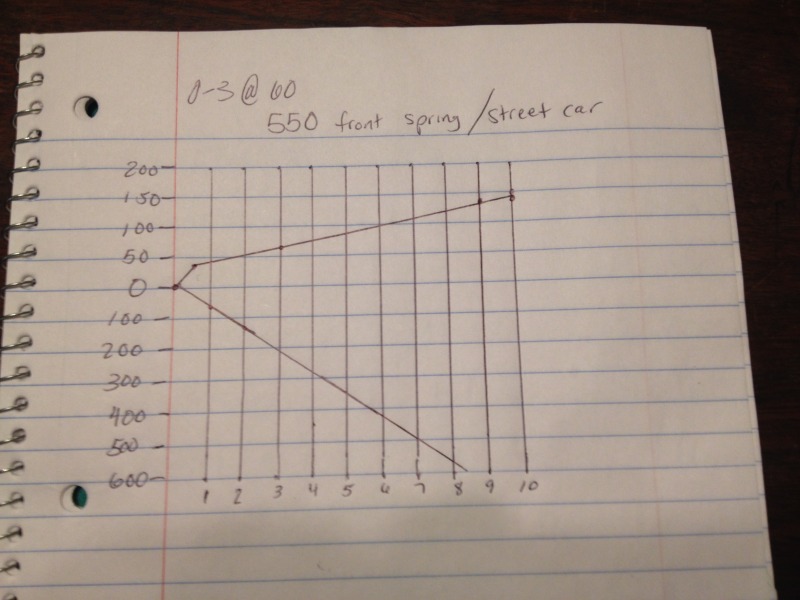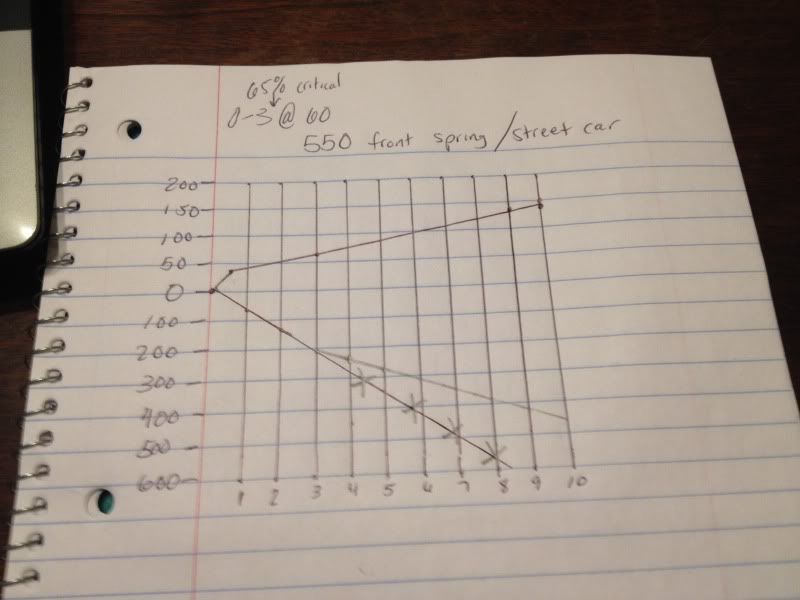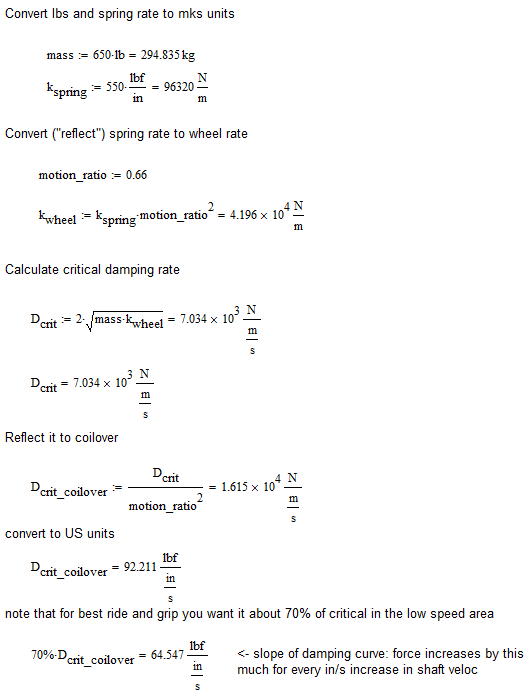Critical Damping Calculation
#3
Badass, thanks.
Am I on the right track for a non adjustable Bilstein. I used 65% critical by 3s because this link.
http://farnorthracing.com/autocross_secrets19.html

Edit: Actually it should taper off to .3-.4 of critical on the high speed rebound right? Like this...

Early .5s knee on the LS Bump to help with ride quality and turn in, late .3s knee on LS rebound for body control? I'm learning so help me out if you please.
Am I on the right track for a non adjustable Bilstein. I used 65% critical by 3s because this link.
http://farnorthracing.com/autocross_secrets19.html

Edit: Actually it should taper off to .3-.4 of critical on the high speed rebound right? Like this...

Early .5s knee on the LS Bump to help with ride quality and turn in, late .3s knee on LS rebound for body control? I'm learning so help me out if you please.
Last edited by jacob300zx; 03-01-2014 at 02:39 PM.
#4
Early blowoff knee in bump doesn't help ride. It helps reduce the aftereffect, the body gaining upward velocity, in a very specific case, which is hitting kerbs on a race track. The other thing that helps this is to have a very flat high speed slope.
For the street you're much better off having the bump knee blowoff occur at a higher velocity, around 3-5 ips (at the wheel). You need the low speed portion to damp out oscillations after hitting a step (either up or down) in the pavement that causes the spring to suddenly compress or extend from rest, up to some size (of the step). After this step input, the peak shaft velocity as the body settles back into its rest position, is a function of the bounce frequency and the size of said step. The knee velocity needs to be at or slightly above this peak velocity of your assumed worst case step input. If it's below, the "recovery" after this step input will be underdamped, and then ride and grip will suffer. It is this settling after bumps/dips that the dampers have to damp. You don't want stiff hi speed damping to cause sharp road bumps/dips to transfer energy (vertical motion) into the chassis.
In the rebound I prefer to also have a flat blowoff above a certain velocity, which is greater than the knee velocity in the bump. This is so that in case of oscillations from a step input greater than the worst case assumed in the one used in calculating the bump knee point, the car will tend to settle biased in the hunkering down direction rather than a tippy toe direction, to keep CG low. The flat blowoff again is to reduce the vertical motion that fast dips impart into the chassis. It is not possible for settling after the spring is compressed all the way to the bumpstops, to generate velocity greater than a certain value, and so any speeds greater than that come from road inputs. Therefore you don't want damping forces to continue increasing all the way to 20 or even 10 ips. It should be flat at some point.
You need more than the 65% number you quoted when you have an early knee, because with an early knee, settling after larger bumps will blow through the early knee and will be underdamped.
The above is IMO based on a bunch of simulations I've done in the past. It is quite different than what you see in most dampers.
The very low speed stuff (< 1.5 ips), is the handling "feel" stuff. Having more rebound than bump will reduce jacking up of the car's outside when you turn-in. Other tricks like where to set the bump/rebound knee front to back, as well as the bounce frequency ratio front to rear, will affect things like porpoising after catching air, etc.
For the street you're much better off having the bump knee blowoff occur at a higher velocity, around 3-5 ips (at the wheel). You need the low speed portion to damp out oscillations after hitting a step (either up or down) in the pavement that causes the spring to suddenly compress or extend from rest, up to some size (of the step). After this step input, the peak shaft velocity as the body settles back into its rest position, is a function of the bounce frequency and the size of said step. The knee velocity needs to be at or slightly above this peak velocity of your assumed worst case step input. If it's below, the "recovery" after this step input will be underdamped, and then ride and grip will suffer. It is this settling after bumps/dips that the dampers have to damp. You don't want stiff hi speed damping to cause sharp road bumps/dips to transfer energy (vertical motion) into the chassis.
In the rebound I prefer to also have a flat blowoff above a certain velocity, which is greater than the knee velocity in the bump. This is so that in case of oscillations from a step input greater than the worst case assumed in the one used in calculating the bump knee point, the car will tend to settle biased in the hunkering down direction rather than a tippy toe direction, to keep CG low. The flat blowoff again is to reduce the vertical motion that fast dips impart into the chassis. It is not possible for settling after the spring is compressed all the way to the bumpstops, to generate velocity greater than a certain value, and so any speeds greater than that come from road inputs. Therefore you don't want damping forces to continue increasing all the way to 20 or even 10 ips. It should be flat at some point.
You need more than the 65% number you quoted when you have an early knee, because with an early knee, settling after larger bumps will blow through the early knee and will be underdamped.
The above is IMO based on a bunch of simulations I've done in the past. It is quite different than what you see in most dampers.
The very low speed stuff (< 1.5 ips), is the handling "feel" stuff. Having more rebound than bump will reduce jacking up of the car's outside when you turn-in. Other tricks like where to set the bump/rebound knee front to back, as well as the bounce frequency ratio front to rear, will affect things like porpoising after catching air, etc.
#5
Sorry for the delay, been in a crazy training class/new job for almost 2 weeks. Do you have a sample graph/dyno of a non adjustable street shock for a Miata with rates used? I'm assuming you have something valved as written above? I'm looking for a super smooth street ride that can take big pot holes and joints with ease, crisp handling, non adjustable, 95% street focused with higher track friendly rates ie 550/350 or 700/400.
Thread
Thread Starter
Forum
Replies
Last Post
stoves
Suspension, Brakes, Drivetrain
5
04-21-2016 03:00 PM
Motorsport-Electronics
ECUs and Tuning
0
09-05-2015 08:02 AM





 .
.






